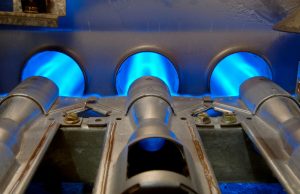
If you use a gas-powered furnace to heat your home, it’s important to be aware of things that can go seriously wrong. A cracked heat exchanger is high on this list. While many of these systems have a safety feature to turn the furnace off if something malfunctions, the signs of a cracked heat exchanger can be subtle and insidious.
This is not a minor repair by any means and isn’t something you should try to handle yourself. If you think you have a cracked heat exchanger, you need to call an HVAC professional ASAP as this is a serious safety issue. Let’s look at the signs of a cracked heat exchanger so you’ll know if this has happened in your home and what you should do about this type of furnace repair in Salt Lake City.
Why Is a Cracked Heat Exchanger a Serious Issue?
To understand why they’re a danger, it helps to understand how the heat exchanger functions. The heat exchanger is a metal container that collects hot combustion gas from the burners. The heat from the gas transfers to the metal walls, causing the exchanger to burn hot. Air from the blower moves around the exchanger and picks up the heat before it passes into the ventilation system. The remaining combustion exhaust in the exchanger is then sent through a flue to escape harmlessly to the outside.
If the heat exchanger has a crack, toxic combustion gases could enter the air that is being blown into the rooms. Although older furnaces are more likely to develop cracks in the heat exchanger, annual furnace maintenance can help avoid this issue.
What Causes Heat Exchangers to Crack?
The heat exchanger’s metal chambers expand and contract as they heat your home. This strain can eventually cause a crack to develop. Due to the reaction between the combustion gases and the metal, corrosion can also weaken the metal, leading to the development of cracks.
What Are the Signs of a Cracked Heat Exchanger?
Because these cracks are invisible to the naked eye, you should be aware of these non-visual signs.
- Your furnace isn’t heating
- You smell odors such as rotten eggs, sulfur, or formaldehyde
- Your carbon monoxide detector is going off
- You’re experiencing symptoms of carbon monoxide poisoning such as headaches, nausea, dizziness, or flu-like symptoms
- Your furnace is making a clicking noise after the blower shuts off
- You can see signs of corrosion on your furnace
What Should I Do if I Suspect My Heat Exchanger Is Cracked?
If anyone in your home is showing the symptoms of carbon monoxide poisoning, you’ll need to evacuate and call your utility company’s emergency phone number. The next step is knowing that this is a problem that can’t wait to be fixed and you should reach out to a professional HVAC company like ours for immediate repairs.
If you suspect you have a cracked heat exchanger, give us a call today and see what keeps our customers saying, “I Love My Design Comfort!”


